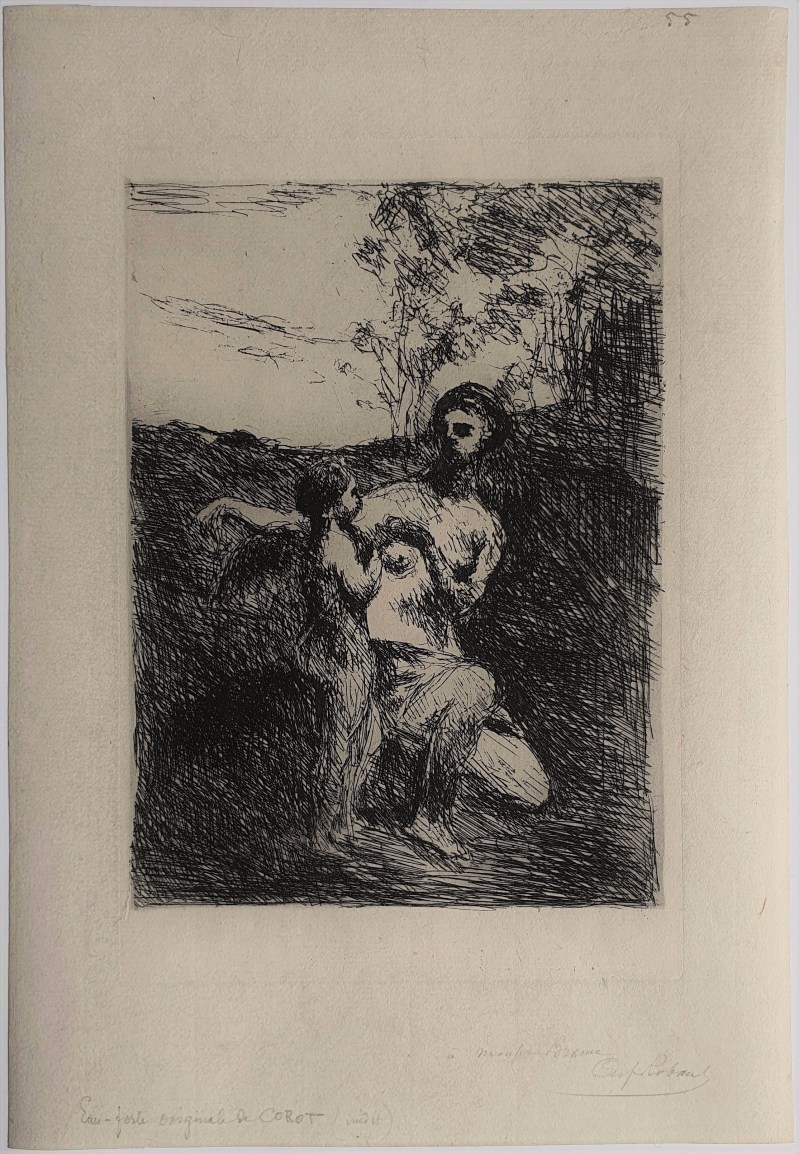Jean-Baptiste Camille COROT: Vénus coupant les ailes de l’Amour, 1re planche - ca. 1869/70
SOLD
[Venus Clipping the Wings of Cupid, 1st plate]
Etching, 240 x 160 mm. Robaut 3132 (titled Vénus coupe les ailes à l’Amour), Delteil 10, Melot 10.
Very fine impression printed on laid paper. In perfect condition. Wide margins (sheet: 325 x 224 mm).
Extremely rare early impression, printed by Alfred Robaut in 1873, dedicated by him à monsieur Brame / Alf Robaut and inscribed in pencil bottom left: Eau-forte originale de COROT (inédit). [Original etching by COROT (unpublished)]
Provenance: Hector Brame, founder in 1864 of the Brame gallery, today Brame et Lorenceau, and heirs.
In a handwritten note mentioned by Loÿs Delteil, Alfred Robaut, a close friend of Corot and the editor of the artist’s catalogue raisonné, describes the circumstances in which Corot gave him three copperplates in 1872. These unpublished copperplates had been etched a few years earlier, and Robaut had them printed in 1873: the first versions of Vénus coupant les ailes de l’Amour [Venus Clipping the Wings of Cupid], Souvenir des fortifications de Douai [Memory of the Ramparts at Douai] and Dôme florentin [Florentine Dome].
“On 6 June 1873 I had Salmon do a trial run of this plate and the next two. I had him make 2 impressions of each on mould-made paper – Holland paper – and 5 impressions on loose china paper. M. Delaunay Alf. took care of the biting of the plates; they were, especially on the next landscape, in a frightful condition. The ground had cracked and was full of scratches, due to the plates rubbing against each other in storage as they were kept in a drawer. The Master found them last winter and gave them to me, because he couldn’t do anything with them… On 14 November 73 I had Cadart make 2 impressions of each on japan paper. » (as quoted by L. Delteil, catalogue no. 10, our translation)
It is not the first time that Corot abandons a copperplate before biting. Claude Bouret, acknowledging the central part played by Corot’s 14 etchings in 19th century printmaking, concedes that Corot is “incapable of taking care of the copperplate biting or of printing trial runs” of his etchings, and that he has to rely for this on professional printmakers who, luckily for him, are ready to help him and “whose technical know-how proves indispensable”: Félix Bracquemond, Jules Michelin, Alfred Delauney. Bracquemond is the one who, around 1865, encourages Corot to rework his first copperplate, Memory of Tuscany, etched twenty years earlier, and to have a few impressions made. The etching will only be published in 1875, after Corot’s death. Corot also relied on the help of Bracquemond and Jules Michelin in order to deliver three engravings to the Société des Aquafortistes (of which he became a member from the start); these were published in 1863 and 1866.
Since none of the two versions of Venus Clipping the Wings of Cupid were ever published, the extant impressions are extremely rare. Alfred Robaut mentions a 9-copy print run made under his direction in 1873 (2 on Holland laid paper, 5 on china paper and 2 on japan paper). In 1910, Loÿs Delteil mentions three impressions sold at auction: one from the collection of Hector Giacomelli, wich sold for 70 fr. in 1905 (printed on japan paper), and two (one of which on japan paper) that had belonged to Alfred Robaut, which sold for 95 fr. and 90 fr. respectively in 1907. One impression from the collection of Alfred Robaut was presented to the Bibliothèque nationale by Étienne Moreau-Nélaton in 1927. The impression in the Budapest Museum of Fine Arts is dedicated by Robaut à mon ami Roger Marx [to my friend Roger Marx]. The copperplates for both versions of Venus Clipping the Wings of Cupid were bought by Edmond Sagot in the sale of the Alfred Robaut collection in December 1907. A restricted print run was ordered by Maurice le Garrec around 1920.
Corot made several sketches of Venus or a nymph disarming Cupid or clipping his swings. The Louvre has two studies in pencil: Venus Clipping the Wings of Cupid (around 1855) in a 58-sheet album (Robaut, no. 3049 - Louvre, no. 8707, notebook no. 12); and Nymph disarming Cupid (around 1856) sketched in another notebook (Robaut, no. 3095 - Louvre no. 8720, notebook no. 58). Corot also exhibited in the 1857 Salon an oil painting with the title Nymph disarming Cupid (Robaut no. 1100), which is in the Musée d’Orsay today. Apart from the two etchings, he drew the same subject again in 1870 in a preparatory drawing: Venus Clipping the Wings of Cupid (Robaut, no. 2940 – Louvre, no. 8816), and an oil painting that was exhibited at the École des Beaux-Arts in 1875: Venus Holding Cupid and Clipping his Wings (Robaut no. 1998).
References: Alfred Robaut, L'œuvre de Corot, catalogue raisonné précédé de l'histoire de Corot et de ses œuvres par E. Moreau-Nelaton, Paris, 1905; Loys Delteil, Le Peintre-graveur illustré, volume V, Corot, 1910; Estampes et dessins de Corot, Bibliothèque nationale, 1931; Michel Melot, L’œuvre gravé de Boudin, Corot, Daubigny, Dupré, Jongkind, Millet, Théodore Rousseau, Paris, 1978; Corot, le génie du trait. Estampes et dessins, Paris, 1996.



